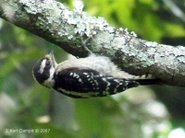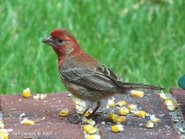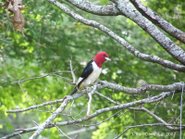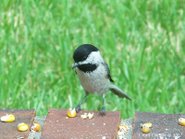 I recently got a bird bath for my backyard. My bro-in-law Kevin hooked me up with one that has a fountain on it. The birds love the tiered levels and the water trickling down. I saw my first Carolina Wren after it took a quick bath and was basking in the sun to dry.
I recently got a bird bath for my backyard. My bro-in-law Kevin hooked me up with one that has a fountain on it. The birds love the tiered levels and the water trickling down. I saw my first Carolina Wren after it took a quick bath and was basking in the sun to dry.
I saw the wren again today feeding on the peanut butter suet block I have hanging in a tree in the backyard. Carolina Wren's are identified by their bright rusty color and long bold white 'eyebrow'. Their bills are long and decurved. Both sexes have the same distinguishing visual markings.
Carolina Wren's are identified by their bright rusty color and long bold white 'eyebrow'. Their bills are long and decurved. Both sexes have the same distinguishing visual markings.
This little bird is one of Kevin's favorites. He had a nesting pair have two broods last year in a basket on his front porch. Once a pair of Carolina Wrens bond, the pair will stay together for life!
Thursday, June 28, 2007
Carolina Wren in the Morning
Monday, June 25, 2007
Red-Headed Woodpecker Bird Watching
There are several Red-Headed Woodpeckers in my area. These woodpeckers are probably my favorite. They are one of the most distinctive and unmistakable birds around, hands down.
They frequent my feeders daily, coming back multiple times during the morning and late afternoon. They seem to be partial to black oil sunflower seeds and cracked corn.
The Red-Headed Woodpecker hunts from a low perch, flying down from their perch to pick up their prey or nut. Their population is reported to be in a steady decline, losing up to 50% of their population since 1966. The decline is at 4.6% per year since 1980. Their population size is estimated to be around 2.5 million. See related article over at the Audubon Society.
Their population is reported to be in a steady decline, losing up to 50% of their population since 1966. The decline is at 4.6% per year since 1980. Their population size is estimated to be around 2.5 million. See related article over at the Audubon Society.
With that news, it makes the picture I got that much sweeter. A juvenile Red-Headed Woodpecker landed in my backyard and started foraging for food. Its Mother (or Father) flew around while it was close to the house. I was able to get several pics before it flew off. I'll definitely be keeping a closer eye out for his (or her) return.
Saturday, June 23, 2007
Bird Watching Tips and Scissor-Tailed Flycatcher
I found a great link over at The Nemesis Bird which offer 10 Ways to See More Birds. I definitely found these tips to be very helpful.
 I got some great shots of a Scissor-Tailed Flycatcher feeding her young. There were five juveniles waiting eagerly to be fed. Lake Monticello has turned out to be great place in my area to catch many species.
I got some great shots of a Scissor-Tailed Flycatcher feeding her young. There were five juveniles waiting eagerly to be fed. Lake Monticello has turned out to be great place in my area to catch many species.Thursday, June 21, 2007
Lake Monticello Birding Hotspot
 I went back to Lake Monticello again yesterday afternoon. It is definately turning into a birding hotspot! I observed a new species for me, a Loggerhead Shrike. There were several flying around at the Plantersville Access.
I went back to Lake Monticello again yesterday afternoon. It is definately turning into a birding hotspot! I observed a new species for me, a Loggerhead Shrike. There were several flying around at the Plantersville Access.
Loggerhead Shrikes are a hunting songbird are very similar to the Northern Shrike only smaller and have an especially broader black mask.
Shrikes prey on small insects, mice, lizards, and even small birds. They impale their prey on thorns or barbed wire in order to kill them and eat. They will even leave their excess kill on the thorns and barbed wire. Their presence in an aread can often be denoted in this way.
Tuesday, June 19, 2007
Birdwatching At Lake Monticello
 This afternoon, Bailey (our Cocker Spaniel) and I went bird watching at Lake Monticello. I was hoping that we would get to see a few new birds that I haven't seen before. We started out on the east side of the lake at the Plantersville access. Those hopes came true as I spotted two Eastern Kingbirds. They both were perching high in a tree and took several flights to catch passing insects.
This afternoon, Bailey (our Cocker Spaniel) and I went bird watching at Lake Monticello. I was hoping that we would get to see a few new birds that I haven't seen before. We started out on the east side of the lake at the Plantersville access. Those hopes came true as I spotted two Eastern Kingbirds. They both were perching high in a tree and took several flights to catch passing insects.
We then went to the west side of the lake to the Hunger Run access. I caught sight of a Scissor-Tailed Flycatch perching on a chain, surveying the open field for insects.

As I got closer, he flew over the pavilion to perch in the open field by the boat access. He stayed there for several minutes, almost posing as I snapped off several pictures.
I have seen Scissor-Tailed Flycatchers before and have taken a few pictures. If you are ever in Pine Bluff at the Pines Mall, take careful notice on the traffic signs around the mall, they are usually perched atop, waiting for their next meal.
Friday, June 15, 2007
Birds of Brush Mountain
 Shelley and I spent Saturday and Sunday up on Brush Mountain with her brother, Kevin, and his wife, Summer. I saw several birds that I had not seen in my backyard in Southeast Arkansas.
Shelley and I spent Saturday and Sunday up on Brush Mountain with her brother, Kevin, and his wife, Summer. I saw several birds that I had not seen in my backyard in Southeast Arkansas.
They have a pair of nesting Eastern Phoebes at their house. Phoebes like to nest on man-made structures, which this pair have. Their nest is on a perch on Kevin and Summer's house.
Easter Phoebes also have a very distinctive feature. They wag their tail constantly when perched. I also saw a Chipping Sparrow foraging on the ground next to Kevin's chicken coup. This sparrow has a rufous crown and a dark eye-line which helps to identify it from other sparrows.
I also saw a Chipping Sparrow foraging on the ground next to Kevin's chicken coup. This sparrow has a rufous crown and a dark eye-line which helps to identify it from other sparrows.
I also caught several pictures of the Chipping Sparros in trees around their house.
I saw two other birds I had not seen before. One was an America Goldfinch. The other was a Summer Tanager, which we spotted very late in the evening. I was not able to get a picture of either of these two. I will on the next trip!
I caught this picture of one of the chipmunks in the woods. He was very quick and is alot smaller than he appears in the picture.
I was very pleased to get this picture as I had never seen one before.
Sunday, June 10, 2007
Northern Flickers!
 I've been watching a pair of Northern Flickers in an oak tree nearby. They have been working on their nest. Hopefully, I'll have a some nice pictures of a few baby flickers soon.
I've been watching a pair of Northern Flickers in an oak tree nearby. They have been working on their nest. Hopefully, I'll have a some nice pictures of a few baby flickers soon.
These flickers are the yellow-shafted variety. They (both male and female) have distinct red nape patch where the red-shafted variety does not have the red nape patch. The yellow-shafted male has a black mustache. The red-shafted male Northern Flicker has a red mustache.
The yellow-shafted male (above picture) also has a yellow underwing and yellow tail, normally only visible in flight, but I happened to catch the male displaying his plumage in the above picture. You can also see it's black mustache. The female (right) is very similar to the male but without the distinct black mustache.
Northern flickers have very distinct markings. They have a black bib on their breast. The black spots on their belly and black bars on their backs help to easily identifiy this woodpecker from others.
Wednesday, June 6, 2007
Finches, Finches, Finches!
My bro-in-law, Kevin, and I were sitting at the kitchen table last Saturday morning watching the birds when several male and female House Finches decided to it was time for breakfast. About 6-8 converged all at once on our birdseed and sunflower feeders.

As a couple finches were waiting for their turn on the feeder, they did something we thought was very interesting. A few began to sip sugar water from the nearby hummingbird feeder. They lost interest in the birdseed feeders and began taking turns taking a drink!
House Finch
This male house finch is a regular in my backyard. He has now started bringing his friends and can be seen during the day feeding on black oil sunflower seeds.


















